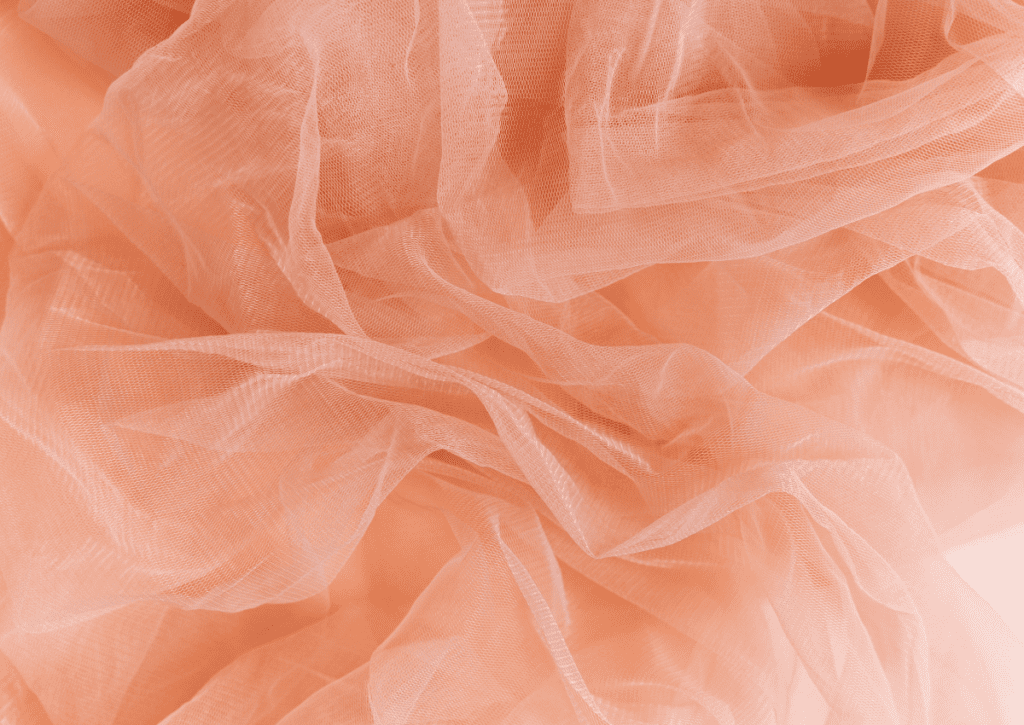Tulle is a mesh fabric often associated with ballet dancers and weddings, adding a touch of elegance. Tulle originated from Tulle, France and has been used for many special occasions. Different types of tulle fabric can be made from silk, nylon, rayon, or polyester.

I recently wrote a guide about the different types of fabrics and their characteristics, including woven or knit, natural or man-made fabrics. However, there are so many fabrics out there that I felt I had only scratched the surface!
In this blog post, we’ll take a closer look at tulle, where it comes from, its characteristics, and how it can be used. Even if you’re new to sewing, learning about tulle will give you the confidence to create beautiful, elegant designs.
As an Amazon Associate, I earn from qualifying purchases. Read my full disclosure here.
What is Tulle Material?
Tulle is a lightweight, sheer fabric that originated in the French city of Tulle in the early 19th century. Tulle has a beautiful hexagonal pattern that looks like netting. With its softness, lightness, and ability to hold shape well, it’s a popular choice for bridal gowns and couture or high-fashion garments.

Tulle is made from a variety of materials such as:
- Silk
- Rayon
- Nylon
- Polyester
- Cotton
One of the first things I think of when I think about Tulle are ballet tutu skirts!
It’s also a popular choice for the skirt of a wedding dress because it provides a sturdy and supportive frame. And that’s not all! Tulle can also create beautiful veils, often adorned with delicate lace or dazzling beads.
Tulle was originally produced in France but is now made worldwide. However, genuinely exceptional tulle fabrics are still produced in France.

How is Tulle Made?
Did you know that tulle can be made in different ways depending on what it will be used for? The main thing that sets different types of tulle apart is the size of the holes in the fabric.
Back in the early 1800s, a man named John Heathcoat invented a machine that could make tulle. Before that, people had to make tulle by hand, which was time-consuming and difficult.
Tulle is created through a unique process called “bobbinet weaving.” It’s made by weaving fine threads, usually made of silk, rayon, nylon, or polyester, together in an open-weave pattern using a series of needles. This creates a delicate, lightweight netting fabric with hexagonal holes, which is what makes tulle so distinctive.
Over the years, the machine Heathcoat invented has improved slightly, but it’s still pretty similar to the original design. Nowadays, some people still make tulle by hand, using special tools to weave the fabric together. But no matter how it’s made, tulle is a really delicate and beautiful fabric that can add a special touch to all kinds of things.
Uses for Tulle Fabric
- Wedding Dresses – Tulle is a material commonly associated with bridal elegance, often used in wedding dresses to create stunning skirts, veils, and elaborate overlays.
- Formalwear – Tulle adds a graceful and sophisticated touch to formal gowns, ballroom dresses, and evening wear.
- Ballet and Dance Costumes – The lightweight, soft, and airy nature of tulle makes it a staple fabric for ballet tutus and dance costumes.
- Veils and Headpieces – Tulle is perfect for crafting veils and delicate headpieces.
- Decorations – Tulle fabric can be used in event decorations, such as table runners, chair sashes, and backdrop draping.
- Crafts – From gift wrapping to creating hair accessories and embellishments, tulle is popular in various craft projects.

Tulle vs Netting Fabric – Are they the same?
Netting and tulle fabrics are similar woven, lightweight fabrics with different stiffness levels. Tulle is softer and more pliable, making it suitable for creating garments with a gentle and romantic silhouette, such as wedding dresses, ballet tutus, and veils. On the other hand, the net fabric can vary in stiffness and is often used for structured designs like sports apparel, activewear, and accessories like hats and veils.
Cheap netting is found in hobby stores and is more for crafting or decorating than garments.
Organza vs Tulle Fabric – What is the difference?
Organza and tulle are lightweight and sheer fabrics, making them suitable for overlays and decorative elements. However, organza has a stiffer drape than tulle, which can create more structured designs with a touch of crispness. However, delicate organza may have a slightly less soft feel than tulle.
Types of Tulle Fabric
Since the good old days when things were hand-crafted, tulle is now produced worldwide using different types of threads. Some are man-made fibres like nylon and polyester, and some are natural fibres like silk and cotton.
Let’s explore the different options below:
1. Silk Tulle
Silk tulle is known to be the softest and most delicate type of tulle fabric. It is also the most expensive since it is 100% silk, and because of this, it is not commonly found. It is used for expensive garments like couture or bridal gowns.
2. English Silk Tulle
English silk tulle has a slightly heavier and more textured feel. It is often used for creating full skirts and ball gowns, offering a classic and elegant look.
3. French Silk Tulle
French silk tulle is lightweight and delicate, making it perfect for adding layers to a garment without all the added weight.
4. Italian Tulle
Italian tulle, typically made from nylon or silk fibres, is a sheer and gauzy fabric with a soft texture and lightweight feel, perfect for creating a romantic look.
5. Nylon Tulle
Nylon tulle is the most common type and is widely used in various sewing projects. It is affordable, easy to find, and offers a good balance between softness and stiffness.
6. Polyester Tulle
Polyester tulle is known as ‘net fabric’ and is a budget-friendly option commonly used in craft projects and decorations. It’s available in a wide range of colours.
7. Cotton Tulle
Cotton tulle is similar in quality to pure silk but cheaper. 100% cotton tulle is not as strong as silk tulle, so keep this in mind. It might not hold up if you plan on using it for something like a wedding gown that will be put under stress.
8. Glitter Tulle
Glitter tulle is an awesome option if you’re looking for a bit of shine. It has little glitter specks woven into the fabric.

Tips for Sewing with Tulle Fabric
- Cutting – For the best results, ensure you have sharp scissors or a rotary cutter when cutting tulle. Since tulle is very lightweight, cutting it can be difficult, but take your time. It doesn’t fray, thanks to the way it’s been made! – Guide to cutting out fabrics.
- Pins and Clips – Use lots of pins or clips to help hold the tulle in place when you sew.
- Sewing – It’s best to go for finer needles and lightweight thread types. This will help you avoid snagging or puckering. You can use a straight stitch or a narrow zigzag; both will work great!
- Handling – Be gentle. This fabric can easily stretch or become distorted, so take your time and carefully handle it.
- Seam Finishes – For neat and tidy seams, try using French seams or pinking shears to finish off the seams. This will prevent any raw edges from showing through the sheer material.
- Heat – Tulle doesn’t like heat, so don’t use an iron on the fabric.
Caring for Tulle Fabric Garments
If you want to keep your tulle outfits in good shape, taking care of them properly is important. The best way to do this is by hand washing them with a gentle detergent in cold water. This will help avoid any damage from using a washing machine.
After washing, gently shake out your tulle garments to avoid excessive wrinkles and hang them up immediately to dry.
For small stains, spot clean with a damp cloth or sponge and mild soap. Allow tulle garments to air dry by hanging them on a padded hanger or laying them flat on a clean, dry surface.
Store tulle items carefully, either hanging or gently folded in tissue paper, to prevent creasing and dust accumulation. If your tulle garment becomes wrinkled, use a handheld garment steamer on very low heat from a distance to remove the wrinkles gently. Or you can place it in your bathroom to be steamed by the shower.
You can learn more about the different types of fabrics – I also have guides covering the different types of sustainable fabrics and the different types of clothes linings and types interfacing fabrics too!